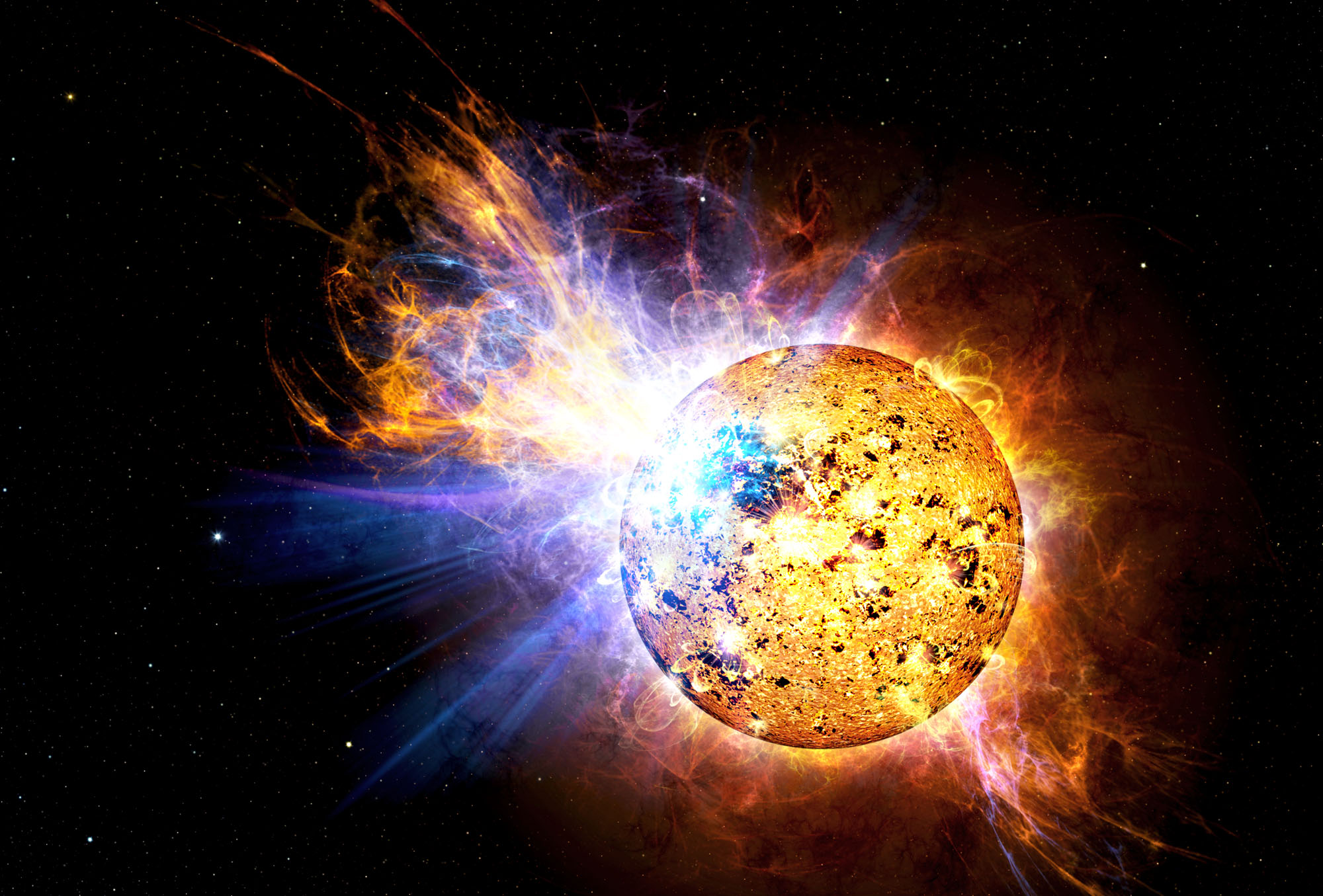Primordial black holes are thought to have formed early in the evolution of the universe. None have been discovered yet but if they do exist and they may be plentiful, drifting almost invisibly through the cosmos, then they might account for dark matter. One possible way to search for them is to see the results of their meals and a bizarre new theory suggests low mass black holes could be captured by neutron stars and become trapped inside, devouring them from within. If these strange objects existed then it would make neutron stars less common in locations where black holes would proliferate as observed around Galactic centre.
Continue reading “How a Black Hole Could Eat a Neutron Star from the Inside Out”If Advanced Civilizations Using Quantum Communications, Is That Why We’ve Never Seen Them?
Establishing communication with an alien intelligence is one of the news items I, and I’m sure many others, long to see. Since we have started the search for advanced civilisations we have tried numerous ways to detect their transmissions but to date, unsuccessfully. A new paper suggests quantum communication may be the ideal method for interstellar communication. It has many benefits but the challenge is that it would require a receiver over 100km across to pick up a signal. Alas they know we don’t have that tech yet!
Continue reading “If Advanced Civilizations Using Quantum Communications, Is That Why We’ve Never Seen Them?”Elliptical Orbits Could be Essential to the Habitability of Rocky Planets

A seismic shift occurred in astronomy during the Scientific Revolution, beginning with 16th-century polymath Copernicus and his proposal that the Earth revolved around the Sun. By the 17th century, famed engineer and astronomer Galileo Galilei refined Copernicus’ heliocentric model using observations made with telescopes he built himself. However, it was not until Kepler’s observations that the planets followed elliptical orbits around the Sun (rather than circular orbits) that astronomical models matched observations of the heavens completely.
As it turns out, this very quirk of orbital mechanics may be essential to the emergence of life on planets like Earth. That was the hypothesis put forth in a recent study by a team of astronomers led by the University of Leeds. According to their work, orbital eccentricity (how much a planet’s orbit deviates from a circle) can influence a planet’s climate response, which could have a profound effect on its potential habitability. These findings could be significant for exoplanet researchers as they continue to search for Earth-like planets that could support life.
Continue reading “Elliptical Orbits Could be Essential to the Habitability of Rocky Planets”2024 Perseids Light Up the August Sky
That ‘Old Faithful’ of meteor showers the Perseids peak early next week.
Great ready for one of the surefire astronomical events of 2024, as the peak for the Perseid meteors arrives next week.
To be sure, the Perseids aren’t the most intense annual meteor shower of the year; in the first half of the 20th century, that title now goes to the December Geminids. What the Perseids do have going for them is timing: they typically arrive in early August, before the academic year starts and during prime camping season, which finds lots of folks out under warm summer skies.
Continue reading “2024 Perseids Light Up the August Sky”Habitable Planet’s Orbiting Red Dwarf Suns Could at Risk from Far-Ultraviolet Radiation
The question of whether or not red dwarf stars can support habitable planets has been subject to debate for decades. With the explosion in exoplanet discoveries in the past two decades, the debate has become all the more significant. For starters, M-type (red dwarf) stars are the most common in the Universe, accounting for 75% of the stars in our galaxy. Additionally, exoplanet surveys indicate that red dwarfs are particularly good at forming Earth-like rocky planets that orbit within their circumsolar habitable zones (CHZs).
Unfortunately, a considerable body of research has shown that planets orbiting red dwarf suns would be subject to lots of flare activity – including some so powerful they’re known as “superflares.” In a recent study led by the University of Hawai’i, a team of astrophysicists revealed that red dwarf stars can produce stellar flares with significantly more far-ultraviolet radiation than previously expected. Their findings could have drastic implications for exoplanet studies and the search for extraterrestrial life on nearby rocky planets.
Continue reading “Habitable Planet’s Orbiting Red Dwarf Suns Could at Risk from Far-Ultraviolet Radiation”Starlink Direct-to-Cell Satellites are Coming. What Will Be Their Impact on Astronomy?
Mention the name Starlink among the astronomy community and you will often be greeted with a shudder. There are now thousands of Starlink satellites orbiting Earth providing internet connectivity to every corner of the Earth. Many believe they are making astronomy difficult but now, SpaceX is launching another service; ‘direct-to-cell’ technology that will allow mobile phones to use satellites to send text messages as early as this year. Voice and data services are likely to follow on quickly next year. With smaller antennae at a lower altitude what is their impact on astronomy?
Continue reading “Starlink Direct-to-Cell Satellites are Coming. What Will Be Their Impact on Astronomy?”Fast-Tracking the Search for Habitable Worlds

Modern astronomy would struggle without AI and machine learning (ML), which have become indispensable tools. They alone have the capability to manage and work with the vast amounts of data that modern telescopes generate. ML can sift through large datasets, seeking specified patterns that would take humans far longer to find.
The search for biosignatures on Earth-like exoplanets is a critical part of contemporary astronomy, and ML can play a big role in it.
Continue reading “Fast-Tracking the Search for Habitable Worlds”Astronomers See Planets Forming Around Binary Stars
Over 5,000 exoplanets have been discovered around distant star systems. Protoplanetary disks have been discovered too and it’s these, out of which all planetary systems form. Such disks have recently been found in two binary star systems. The stellar components in one have a separation of 14 astronomical units (the average distance between the Earth and Sun is one astronomical unit) and the other system has a separation of 22 astronomical units. Studying systems like these allow us to see how the stars of a binary system interact and how they can distort protoplanetary disks.
Continue reading “Astronomers See Planets Forming Around Binary Stars”China's Lunar Samples Contain Graphene Flakes

In 2004, scientists at the University of Manchester first isolated and investigated graphene, the supermaterial composed of single-layer carbon atoms arranged in a hexagonal honeycomb lattice. Since then, it has become a wonder, with properties that make it extremely useful in numerous applications. Among scientists, it is generally believed that about 1.9% of carbon in the interstellar medium (ISM) exists in the form of graphene, with its shape and structure determined by the process of its formation.
As it happens, there could be lots of this supermaterial on the surface of the Moon. In a recent study, researchers from the Chinese Academy of Science (CAS) revealed naturally formed graphene arranged in a special thin-layered structure on the Moon. These findings could have drastic implications for our understanding of how the Moon formed and lead to new methods for the manufacture of graphene, with applications ranging from electronics, power storage, construction, and supermaterials. They could also prove useful for future missions that will create permanent infrastructure on the lunar surface.
Continue reading “China's Lunar Samples Contain Graphene Flakes”The Surface of Dimorphos is Surprisingly New

When NASA’s DART mission intentionally slammed into Dimorphos in September 2022, the orbit of the moonlet was altered. Researchers have studied the photos and data taken by DART before its impact, learning more about the geology of the Didymos/Dimorphos system. They have now estimated the surface age of both the asteroid and its moon. The asteroid Didymos has a surface age of 12.5 million years, while the moon Dimorphos is only 300,000 years old.
Additionally, the DART researchers concluded both Didymos and Dimorphos are rubble piles, with Dimorphos likely inheriting its boulders from Didymos.
“It’s a pile of gravel and boulders (and some sand/dust) held together by its own gravity, and really not anything else,” said Andy Rivkin, DART investigation team co-lead at the Johns Hopkins Applied Physics Lab (APL), on Bluesky. “There’s really no cohesion between different pieces of gravel or rocks on Dimorphos.”
Continue reading “The Surface of Dimorphos is Surprisingly New”





